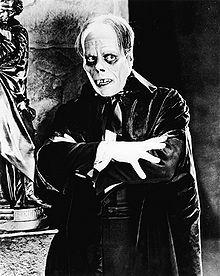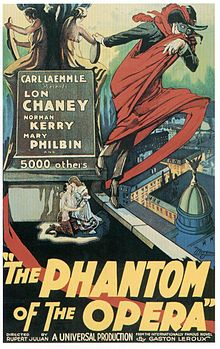The Phantom of the Opera (1925)
| Movie | |
|---|---|
| German title | The Phantom of the Opera |
| Original title | The Phantom Of The Opera |
| Country of production | United States |
| original language | English |
| Publishing year | 1925 |
| length | 106 minutes |
| Age rating | FSK 6 |
| Rod | |
| Director | Rupert Julian , Lon Chaney , Edward Sedgwick |
| script | Elliot J. Clawson , Raymond L. Schrock , Frank M. McCormack |
| production | Carl Laemmle |
| music | Gustav Hinrichs |
| camera | Milton Bridenbecker , Virgil Miller , Charles Van Enger |
| cut | Edward Curtiss , Maurice Pivar , Gilmore Walker |
| occupation | |
| |
The Phantom of the Opera is a feature film by Rupert Julian from 1925. It is based on the novel of the same name by the French writer Gaston Leroux, which was published only fourteen years earlier . The title role was played by "the man of 1,000 faces" Lon Chaney .
action
The opera house is sold in the office during a ballet performance. The new owners do not believe the legends they are told about the Phantom. After the screening, the star of the opera, Carlotta, shows her new boss a threatening letter from the Phantom. The Phantom demands that the female lead in the next performance of Gounod's opera Faust be sung by Christine Daaé. Otherwise, Carlotta's career will end in disaster. On the day of the performance, however, Carlotta is sick; Christine takes her place. Her lover, Viscount Raoul de Chagny, and his brother, Comte Philip de Chagny, sit in their box and watch Christine. After the performance, Christine tells the irritated Raoul to forget the love that binds them together. The Phantom encourages Christine that her decision to go to opera was the right one. Christine writes in a letter to Raoul that he should never meet her again.
Despite a new warning from the phantom, Carlotta appears again the next evening, whereupon the phantom causes the chandelier in the auditorium to fall on the audience. In the panic that followed, Raoul notices a mysterious Persian and hides in Christine's locker room. There he observes how Christine climbs up to the phantom in the underworld, where she is received by him and, meanwhile passed out, is laid by him in his bed. She wakes up again from playing a pipe organ and sneaks up on Erik, the phantom. He had always warned her not to take his mask off, but after some hesitation she does it anyway. Christine falls to the ground, on the one hand frightened by Erik's disfiguring appearance, on the other hand because Erik is threatening to rush towards her.
In the masked ball that follows, the disguised phantom mingles with the guests. Christine is afraid of the phantom and seeks protection from Raoul. The phantom follows them both onto the roof of the opera and overhears them as they decide to flee to England the following day.
The next evening, before the performance of the opera Faust, the body of Joseph Buquet, one of the opera's employees who knew the most about the phantom, is found. Even Philip, who is present during the performance, cannot prevent the Phantom from kidnapping Christine. While the brother of the killed Joseph rounds up an angry mob in front of the opera, Raoul, Philip and the Persian follow the phantom. Philip is drowned by the phantom, the other men can save themselves. Meanwhile, the mob got into the opera underground. The phantom flees with Christine, who escapes the phantom during the escape. The angry mob slays the phantom and throws it into the Seine.
backgrounds
In 1922 Gaston Leroux gave producer Carl Laemmle his novel to read, whereupon he immediately secured the filming rights. He got ahead of the actor Lon Chaney, who actually wanted to secure the rights and instead joined the project as the lead actor. The filming took place on a large stage modeled after the opera house and larger than a football field (and on which, among others, Alfred Hitchcock later turned The Torn Curtain ). Between the director Rupert Julian and the main actor Lon Chaney there were often disputes about the interpretation of the role of the phantom, so that Chaney designed some scenes according to his own preferences. Over time, the film was cut several times and new scenes were added.
Cut versions
- The original version , which was shown as a test screening in Los Angeles in January 1925. It failed the test audience and especially Carl Laemmle. There are no copies, the original has been destroyed.
- The world premiere version that was shown in San Francisco in April 1925.
- The official cut from September 1925, which premiered at the Astor Theater in New York. This version was re-edited and comedy specialist Edward Sedgwick shot additional scenes.
- a reconstructed new cut from 1929 with individual text passages. This version was only performed in the United States. In the 1930s, private individuals could buy 16mm copies of the film to take home. One of these copies has been preserved.
- The sound version from 1930, which was also distributed internationally. This version is available on the one hand as a silent film version and on the other hand as a sound film with acoustic accompaniment as a light tone, changed subtitles and additional scenes.
The only surviving versions of the film are the 16mm copy as well as a reconstructed silent film version of the 1930s version, the latter also being the most commonly seen.
The film was also restored in the 1970s, 1996 and 2003.
There are different film music versions for the different versions. Sam Perry was responsible for the 1929 version but was not mentioned in the credits. More recent compositions were created by Gabriel Thibaudeau and Rick Wakeman (1990), Roy Budd (1993) and Carl Davis (1996).
useful information
The film was classified by the American National Library and the Library of Congress as particularly valuable from a cultural and historical point of view, and in 1998 it was included in the National Film Registry . The film is in the public domain in the United States and can be downloaded for free from the Internet Archive .
The masked ball scene and a scene on the roof of the opera are still preserved today from several scenes originally filmed in two-color Technicolor .
When Christine Daaé is kidnapped by the phantom into his catacombs for the first time, a bed in the form of a front hull with a kind of figurehead can be seen. The same striking prop was also used 25 years later in Boulevard der Twilight as the bed for “Norma Desmond”.
In 2012 the American industrial-Gothic band Frausun released the score in a new guise.
Reviews
"The film has excellent effects that have seldom been shown in a work of art."
“Gaston Leroux's novel was adapted for the big screen a dozen times, but only Rupert Julian's silent film from 1925 became a classic. For the role of the tragic title hero, Lon Chaney transformed his face into a gruesome death mask, which despite all rigidity allowed a nuanced expression. "
“More melodrama than horror film that creates tension with intense, cleverly calculated compositions. Despite excessive signs of age - the echoes of Expressionist backdrops are superficial, the mask image looks outdated - an attractive film, especially in comparison to later, often too gruesome film adaptations of the classic horror story. "
literature
- Gaston Leroux : The Phantom of the Opera. Novel . dtv, Munich 2004, ISBN 3-423-08596-7 ; Original title: Le fantôme de l'opéra
- William K. Everson: Classics of Horror Movies . Goldmann, Munich 1982, ISBN 3-442-10205-7 ; Original title: Classics of the Horror Film
Web links
- Phantom of the Opera at the Internet Movie Database (English)
- Phantom of the Opera at Rotten Tomatoes (English)
- The Phantom of the Opera in the online film database



